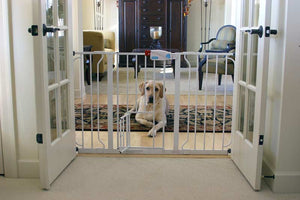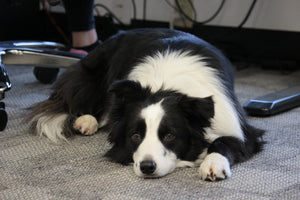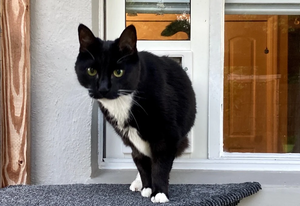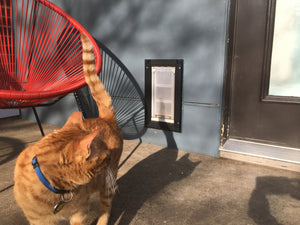Dog Park Etiquette
Co-authored by Stephen Daily and Heather Kalinowski (Trupanion)
At some point or another, every dog owner has thought about taking their dog to the dog park. Walking past one and seeing so many good dogs running, jumping, barking, and having a blast you think “I’m sure my dog would love that!”. Maybe you haven’t gone because you’re scared of having your big dog off-leash, or maybe you just haven’t had the time to learn the basic rules.
Perhaps you and your dog are regulars at the local dog park! Either way, here are some dog park rules you should consider for your first time at a dog park to ensure a positive experience for everyone.
Safety Tips:
1. Do a Lap On-Leash
Dog parks, especially those that are not well maintained, can be full of holes, drop-offs, breaks in fence lines, and other hazards that could harm your big or small dog. Before letting your dog into the off-leash area, walk your dog around the park with your dog on-leash first to look for any potential dangers and try to avoid those areas when you allow your dog off-leash.
This lap will also make your dog more comfortable around new dogs and allow him to get all the initial jitters out before he is allowed full freedom, as well as getting them more adjusted to the dog park size.
2. Carry Your Own Water
Standing water can pose a health risk to old and young dogs, and at dog parks there are often water bowls left standing for long periods of time. To avoid the potential for illness, carry your own water in a water bottle and a portable dog bowl that can be used when your dog becomes hot and thirsty. Also, don’t allow your pooch to frolic in mud puddles or other standing water.
3. Beware of Overheating
When given the freedom to run free off-leash, some high energy dogs may not know when to stop. They become so excited with the adventure that they may overextend themselves. Your dog needs to take a break. As a responsible pet parent, make sure to force your dog to take breaks so they are able to cool down. Make sure they drink enough water as well before running back to their doggie playmate.
4. Avoid Aggressive Dogs

While no pet owner wants to believe another pet owner would allow an unfortunate encounter to occur, sometimes it does happen. When taking your first lap around the park, pay attention to body language that indicates aggressive behavior for which dogs seem well-adjusted and focused on healthy play and which look like they are searching for a dog fight. Avoid any of the latter. Dog park toys might seem like a good idea, but be aware that other dogs might try to steal them!
5. Beware of Your Dog’s Personal Health
Make sure you consult your vet about your dog's overall health, and make sure that it’s up to date on all it’s vaccinations. Never bring a puppy under the age of four months to a dog park, as you will not know if seemingly healthy dogs are carrying diseases or not. And finally, make sure your dog is under constant supervision while you are there. You don’t want to be talking to someone else, or looking at your phone when a catastrophe strikes. Here's also a post on Safety for OutDoor Pets, a list of outdoor factors to be aware and cautious of.
6. Taking a Puppy to the Dog Park
Knowing when to start bringing puppies to the dog park can be hard to know. Generally, you should wait until they have enough social skills to be surrounded by other dogs. Consider staying on the outskirts of the park at first while your puppy is on the leash. This will get them acclimated to being around other dogs. Then, you can introduce them to one or two other dogs at a time, and finally to the whole park.7. Have Fun
While it’s important to be wary of the risks involved in trips to the dog park, it’s not worth going if you aren’t having fun. Once you assess the risks and do your best to avoid them, make sure to show your dog that this is a fun outing by letting go of stress and enjoying the time out in the sun!
Dog Park Etiquette:
1. Pick up after your dog

It’s simply good manners to pick up after your dog no matter where you are going. But it’s especially important at a dog park. There are a lot of parasites and diseases living in dog poop that other dogs can contract when they touch, roll in, or eat it. Let's be honest, that’s disgusting on all counts. So let's avoid gross dogs and the spread of disease by following this simple rule of etiquette. Many dog parks have free poop bags, but it’s always smart to carry your own with you anyways.
2. Misjudging dogs social skills
We’ve all experienced meeting someone with bad social skills: the person who stands way to close when you don’t know them, the awkward situation of the person that simply won’t stop talking, or my personal favorite, the person who shakes your hand for way too long to the point where it’s uncomfortable.

It’s like this for dogs too. Allowing your dog to charge another dog, because it’s excited to meet him, is likely to incite a negative rebuttal. Allowing your dog to mount another dog in a dominance display is lewd and rude. Allowing your dog to sniff another dog after it’s clearly displayed that it’s uncomfortable with being sniffed is also rude. Understanding the basic positive interactions in the dog world, and knowing how to help your dog grow up with those values are essential to having a good experience at a dog park. If you know that your dog does not do too well with other dogs at first, be sure to take precautions in preventing your own dog's aggression before letting them interact with other dogs at the park.
But it’s not only your dog’s social skills that you need to look out for. Before entering any dog park, you should survey the current occupants and distinguish whether or not it’s a safe environment for your dog to enter. Watch for how rough a dog interacts, whether or not there are intact males or females dogs in heat, and how possessive another dog is with it’s toys. The best way to prevent an event is to avoid it completely!
3. Removing collars, harnesses, etc on dogs while they play

Though it may seem logical to keep your collar, choke chain, prong collar, gentle leader, or harness on your dog, it’s a bad idea. The neck, shoulder and muzzle are where dogs most frequently aim when nipping and mouthing while playing. Having metal or any other attachment point is simply inviting broken teeth, jaws, paws, legs, lacerations or other injuries. Also consider what would happen if your panicked dog couldn’t detach itself from another dog's neck, or vice versa. Dogs will often go for the leash because it gives them leverage over the other.
But it goes beyond that as well. Keeping your dog on leash in the middle of an off leash park is just another way to invoke aggression between it and other dogs.
Overall Notes:
If you follow these tips, dog parks can be a great way to get your dog the socializing and exercise that it needs. But as always, use good judgement and make sure your dog is safe!




